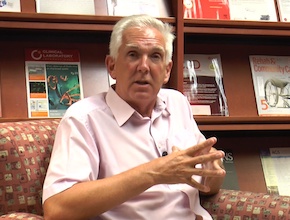Roman Jaeschke: Good morning. Welcome to another edition of McMaster Perspective. It is my pleasure and honor to introduce Professor O’Byrne, whose work guided asthma management over the last few decades. We will be talking about long-acting ß2-agonists in asthma, but I would like to start by reviewing your views on where were we several – if not 20 or 30 – years ago with asthma and where are we now.
Paul O’Byrne: Thank you, Roman. There has been a major change during my career in the way that asthma has been managed, and that is mainly because of the widespread agreement that asthma is a chronic inflammatory disease, and therefore its management must be centered around providing effective anti-inflammatory therapy to the airways. Very fortunately, we have inhaled corticosteroids, which we have known about for probably close to 40 years as being effective, but now the focus is on inhaled steroids as being the core management of asthma. Everything else is added to inhaled steroids in relation to day-to-day management of patients with persistent symptoms.
What has happened as a result of that is that asthma control overall is vastly better than it was. And the very serious events that we all worry about – severe asthma exacerbations requiring acute intervention, sometimes hospital admission, occasionally intensive care unit admission – are much less frequent, and indeed admissions to hospital, particularly in the intensive care unit setting, are now vanishingly rare; when I was starting out they were a common, weekly occurrence in most big general hospitals. That has been a big change in my view.
RJ: So we are better these days – we, you, and the system is better. What is the history of the main topic of our discussion today, which is concerns and use of ß2-agonists, specifically both short acting and long acting.
PO: Once again, I think to understand this it is important to look backwards and see where we started. Close to 4 decades ago it was recognized that inhaled ß2-agonists – drugs that stimulate the ß2 receptor in the airway – cause rapid relief of asthma symptoms associated with very rapid bronchodilation of the airways. Physicians recognize this, and patients recognize this; they get a very quick relief of symptoms of asthma when using a ß2-agonist. The first of these were short acting; they were rapid onset, caused bronchodilation and symptom relief within minutes, but generally lasted somewhere between 3 or 4 hours in duration of effect. But because of the rapid benefit, patients became dependent on that kind of symptom relief, and for a very long time, more than a couple of decades, regular use of inhaled ß2-agonists was considered to be an appropriate therapy, and only if they were not providing good control were patients treated with inhaled corticosteroids.
A one very important consequence of understanding the central role of inflammation was that we very rapidly recognized that ß2-agonists, very effective at dilating the airways, have no direct anti-inflammatory properties in the airway. So when you were managing or the patients were managing themselves with regular ß2-agonist use, they were not treating the inflammation, they were treating the symptoms of the disease.
In the early 1990s, a colleague here at McMaster, Dr. Malcolm Sears, who was then working in New Zealand, did the very first double-blind randomized study of regular ß2-agonist use versus placebo, interestingly, in patients with mild to moderate asthma. What it showed was actually quite shocking to the respiratory community and that was that while regular ß2-agonist use did indeed improve symptoms quickly, overall risks of severe events in asthmatic patients were increased. That is because we now understand the inflammation was not being managed. In fact, that was probably the reason for an epidemic in asthma deaths that had occurred in Australia and New Zealand in the mid-1980s with the release of a very potent and even more rapid-onset short-acting ß2-agonist. This was a very controversial issue, of course, because what we had been recommending to patients was potentially putting patients at great risk.
Around the same time a number of companies developed the same class of drugs, ß2-agonists, but which now had a much longer duration of action, lasting somewhere between 12 and in some instances 24 hours of effects on the receptor, and therefore bronchodilation. But of course, [there was] a tremendous worry that if short-acting ß2-agonists used as a monotherapy in asthma were putting patients at risk, maybe long-acting would put them even at greater risk. And that really was where this whole issue about safety of the long-acting ß2-agonists (LABAs) became a major issue.
RJ: I somehow recall a major discussion surrounding a study which was called SMART. Would you comment on it a little bit?
PO: Certainly. The SMART study was a study mandated by the FDA, Food & Drug Administration, in the United States. At the time of the initial approval of one of these long-acting inhaled ß2-agonists – I am going to call them LABAs, that is what we call them these days – it was a safety study mandated as a phase IV trial once the drug had been approved in the United States. The design of this study, very frankly, was markedly suboptimal. What they did was they recruited asthmatic patients by advertising in media and by telephone, and they posted, mailed out the drug or placebo, and then followed up events over 6 months in these patients. So these patients were not seen in specialty centers, they were predominantly in primary care, and that was a large trial – something like 16,000 to 17,000 patients enrolled over that period of time. What the study showed was that in patients who were given the LABA, salmeterol, when compared to placebo – and this was supposedly added on to regular therapy, although that was not mandated in the trial – the result was that asthma deaths were significantly increased in the salmeterol group when compared to placebo-treated group, and that risk appeared to be greater in African-American populations. Of course, this was enormously concerning to the respiratory community, but in fact quite consistent with what we had already known about the use of short-acting ß2-agonists (SABA) as a monotherapy.
Looking backwards a little bit on the way this study was done, what was clearly the single major flaw was that the LABA, salmeterol, was not mandated to be used with an inhaled steroid. In fact, it is my strong belief that the majority of these patients, getting drugs for free in the United States – a drug which was very effective at relieving symptoms – most of them took that drug but did not use an inhaled steroid with [it].
 English
English
 Español
Español
 українська
українська







